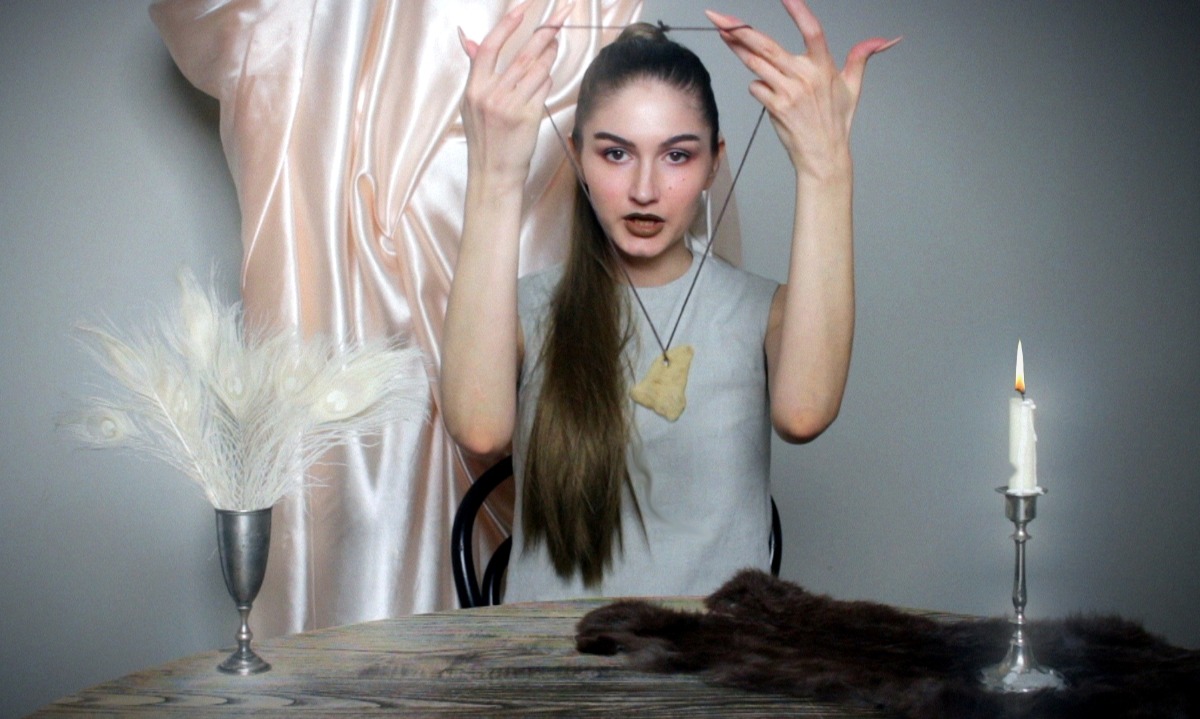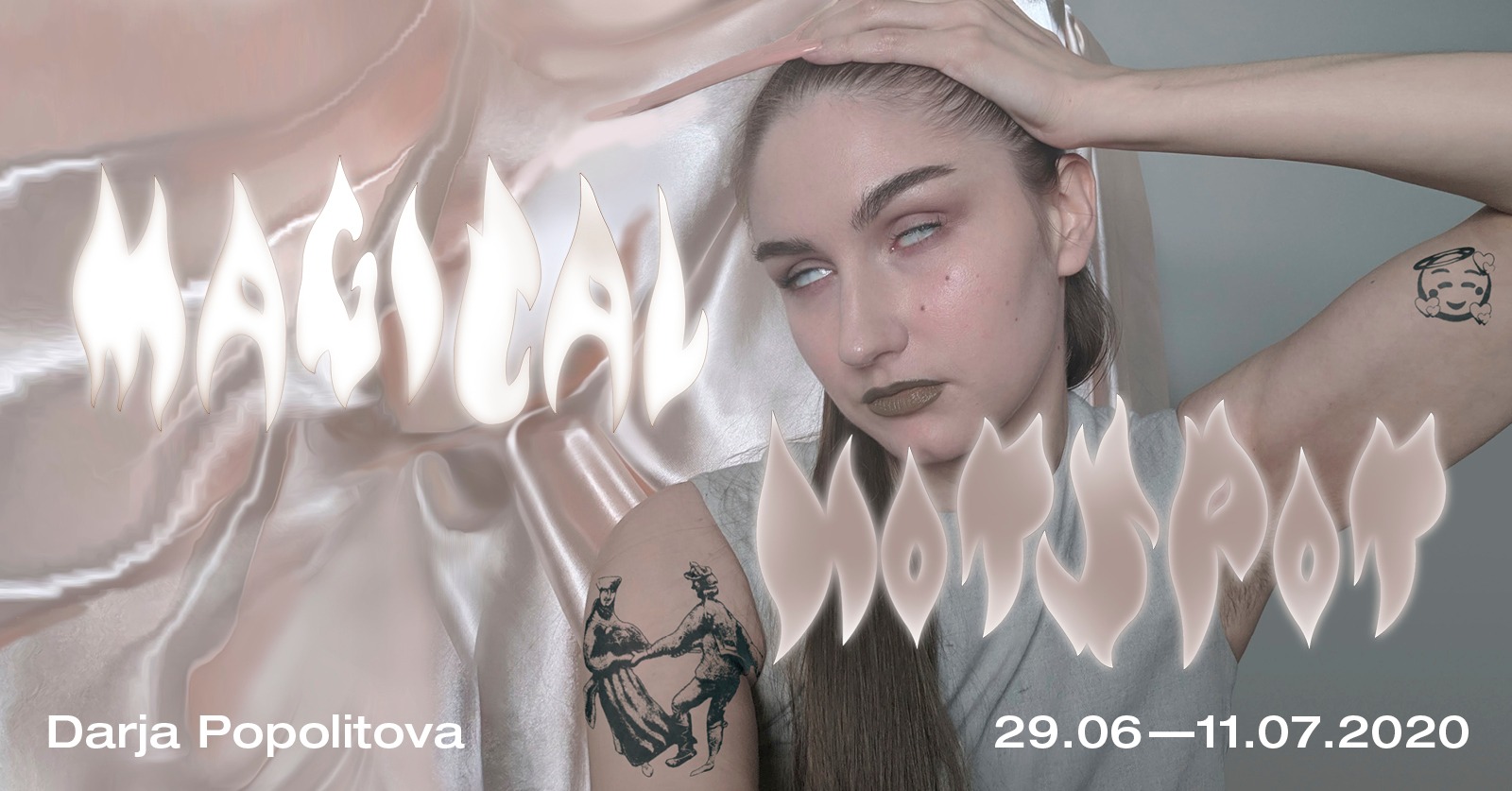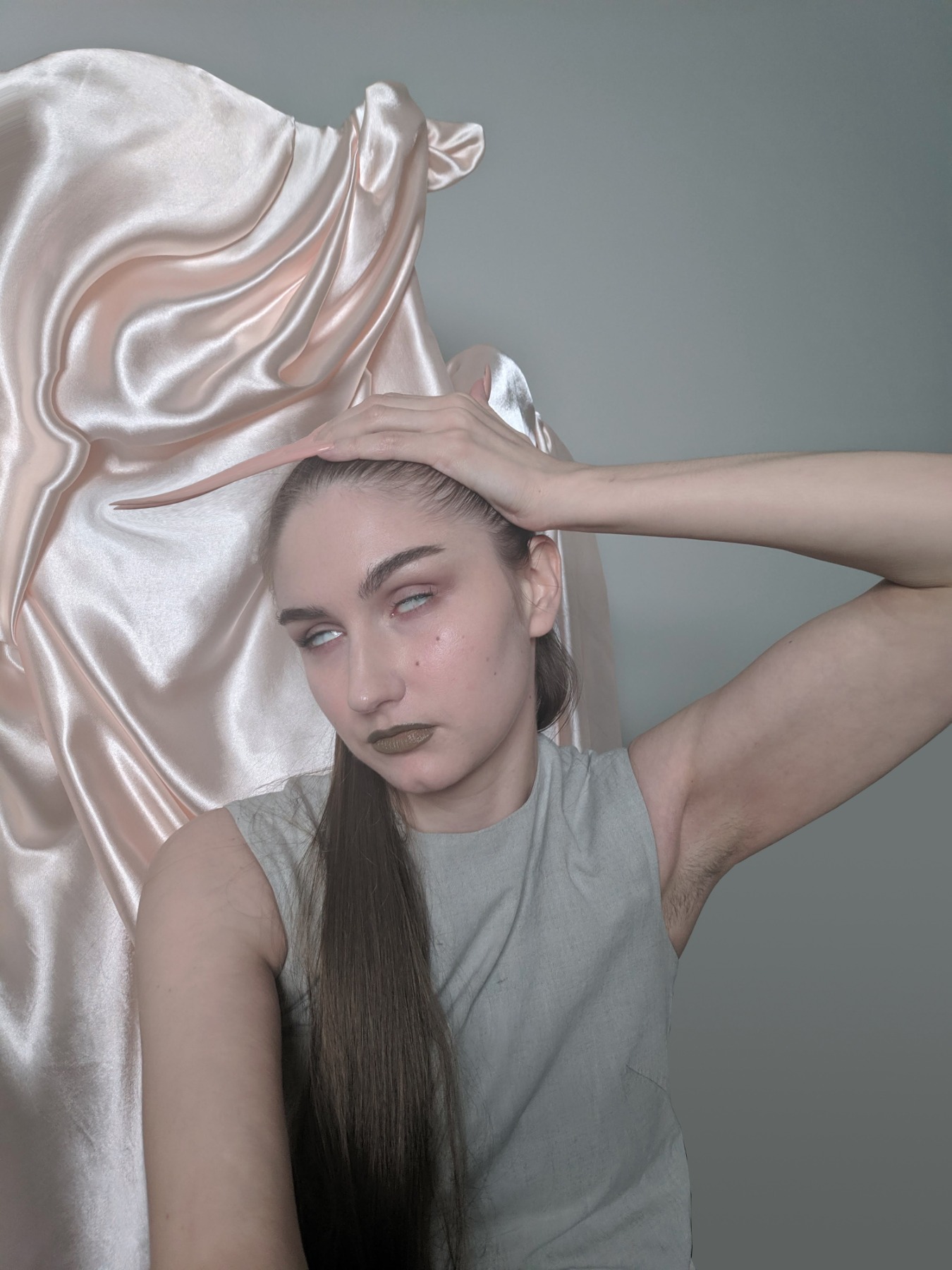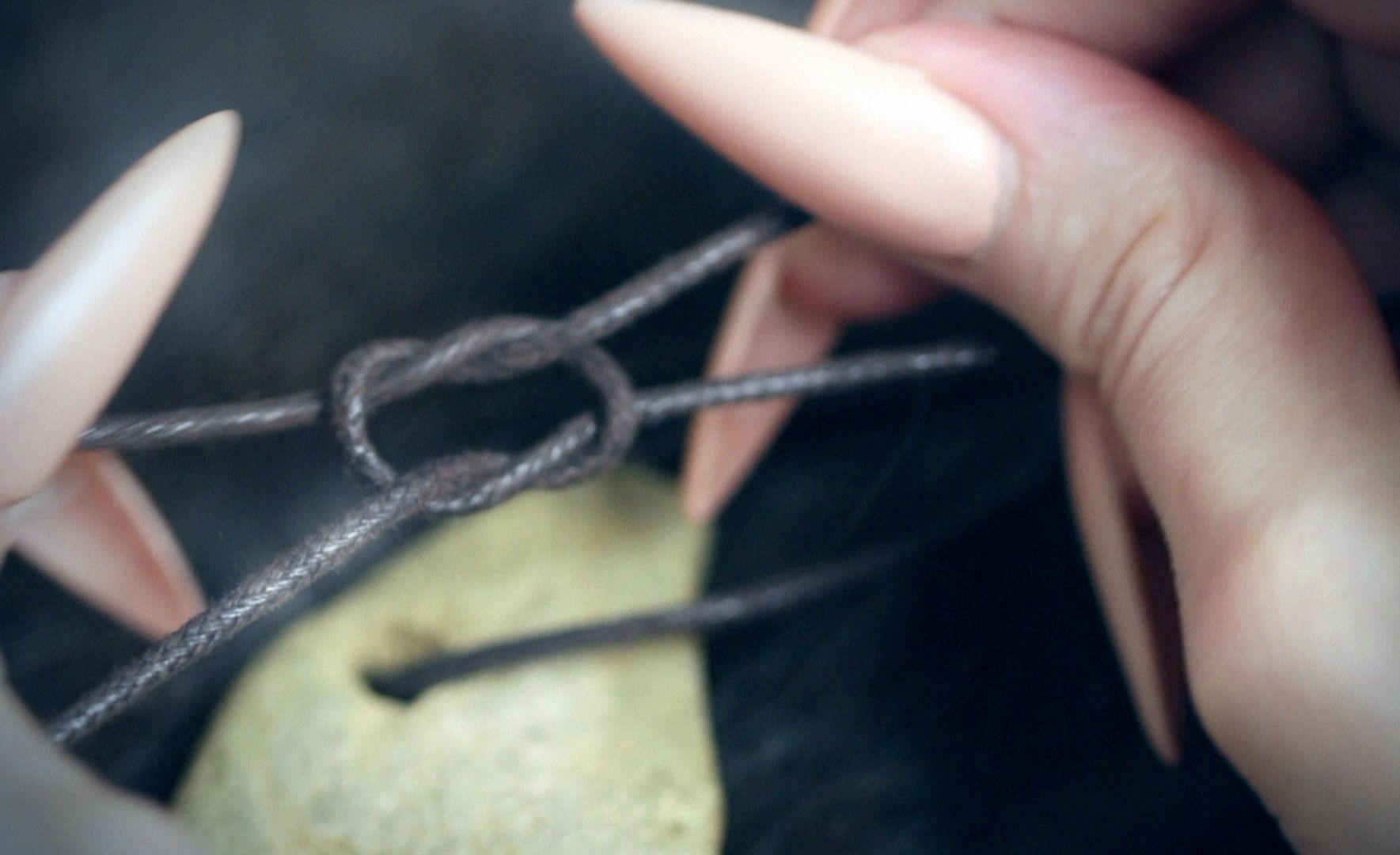
I am the witch
An interview with jewellery artist Darja Popolitova
Vent Space gallery in Tallinn will be presenting Magical Hotspot, the solo show of Russian-Estonian jewellery artist Darja Popolitova, from June 29 to July 11. The exhibition speculates on the themes of magic, social values and internet culture, finding common ground in jewellery and tactility.
Darja Popolitova was born in 1989 in Sillamäe and is currently studying for her doctorate at the Estonian Academy of Arts. In her work, Popolitova studies how tactile interaction with jewellery affects the viewer through the video medium. ‘This year I found an artistic approach in the new vlog genre where people on their YouTube channels perform magic rituals or tell how they’ve eyewitnessed paranormal events. I think this is an interesting phenomenon. As it regards spiritualist-vloggers, there are many stylistic elements characteristic not only of the Internet, but also of ancient sacred techniques. In the process of preparing the exhibition, I fantasized what problems I could solve with the help of magic on my imaginary channel. The answer came from inside – from my personal experience as a millennial Russian-speaking woman in Estonia. I supported my magical intentions with statistics that I found in several official studies,’ reveals Popolitova.
Some of the statistics used in creating the exhibition come from such institutional studies as Integration Monitoring of Estonian Society 2017; Survey of Health, Ageing and Retirement in Europe 2013-2015; and Gender Equality Monitoring 2016. Among the studies’ revelations are the facts that, for instance, only a little over 10% of the residents of other nationalities in Estonia communicate with the Estonian-speaking majority, and less than 10% of Estonian-speaking people communicate with the Russian-speaking population or other nationalities on a daily basis. Another revelation is that in Estonia, 74% of the elderly have no other close person to talk to about their joys and worries.
In the exhibition, three video works and an installation create a fictional world in which the witch-vlogger Seraphita offers ‘magic’ solutions to societal problems – for example, rituals for getting rid of sexism and homophobia, integrating foreigners, or helping the elderly overcome loneliness...albeit the solutions make use of jewellery instead of frog skins and obscure plant roots.
Arterritory.com took the opportunity of the exhibition’s opening to invite Darja Popolitova to a short conversation on jewellery as a medium and its role in today’s quickly changing world.

What fascinates you in contemporary jewellery as a medium, and how do you see its role in the world we are living in right now?
What I really like about contemporary jewellery is that it is open to experiments. A piece of jewellery without actual jewellery? Easy. Now, when there has been a lot researched and investigated about jewellery, an artist can get to the juicy part of the collective knowledge – interpret, make philosophical allegories, criticise, research – and make work at any degree of materiality (physical, visual, linguistic, or oral).
Also, jewellery is more than just an object – it has a rich history of a material entity with symbolic, decorative, monetary, societal and wearable values. For me it is always fun to play around with these values. I map, mix and blend them while carrying my social and cultural roles – artist, millennial, teacher, Russian-speaking, daughter of artists, doctoral student, a woman in Estonia. So the feature I am fascinated by in contemporary jewellery is its potentiality to constantly reflect on itself and on the situations in which it is born.
What attracts many people to an art field is not just a piece of jewellery, or a poster, or a painting per se, but what happens around the work socially and economically. Like exhibitions, publications, seminars, conferences, but also funding young students to go abroad and open up new horizons. The history of contemporary jewellery is familiar with the importance of different economic factors – when in the 60s and 70s a new generation of gallerists, teachers and schools started to inhabit the planet of jewellery. These historical axes showed that it is significant to stay affected by each other in order to produce an effect. A person can visit a jewellery exhibition, encounter a book, and then stay in this field forever. Which is exactly my case: the exhibition of Air Castle (a group of Estonian jewellery artists) in a lighthouse near Kumu Art Museum + a book by Tanel Veenre [an Estonian jewellery artist – ed.] + my Erasmus trip to Bratislava = ‘Hello, can I join this field?’
What attracts many people to an art field is not just a piece of jewellery, or a poster, or a painting per se, but what happens around the work socially and economically.
When there is an interest towards jewellery coming from various professionals, there is no way that new forms of knowledge won't be produced. With jewellery, not only the artist but also a wearer, curator or writer can push limits. This expanding effect makes sense when there is a context for the jewellery – a body, a white cube, an Instagram story, a text or any other expositional form.
On an educational and cultural level, contemporary jewellery makes people dig into the history of the objects that make us unique as humans. It teaches us to notice the silent values of our lives – rituals of giving, intimate moments involving the touching of skin, memories, identity-statements. It reminds us that we are only humans and that it is OK to be sentimental or naive, greedy or generous, full of self-doubt or confident.
In your doctoral studies you are investigating how tactile interaction with jewellery affects the viewer through the video medium. How did this idea come to you, and why did you find it important in a contemporary context? What are your main discoveries from studying this subject?
The idea came to me while going through an exhibition experience – when I analysed my exhibition experience through the prism of bodily, tactile and sensual aspects. The first thing I noticed is that jewellery, as an exhibition item, is very often limited to being gazed at as an object that is meant to be worn on a body. In the history of contemporary jewellery there have been exhibitions which invited the public to touch the jewellery, but this topic did not interest me as such. The reason for that is because my practice includes a lot of digital techniques and perceiving the jewellery through a screen – via 3D modelling and also in photographing or filming. What seemed to me more intriguing was: could the jewellery that is being mediated through the screen impact the viewers’ senses even more than a piece of physical jewellery?
I found confirmations of the activation of the senses of the viewer in the literature on video art, film and media. To mention a few authors: Laura U. Marks, Vivian Sobchak, and Marshall McLuhan. It was long believed that the viewer in the cinema was physically passive. Consequently, the cinematic image affects only cognitive functions. The main idea that recent theories have arrived at is that the sensations from the screen image are perceived not only by the exclusive power of vision, but also as an independent bodily self-affectation.
With this cohort of new theoreticians in mind, I ended up testing jewellery in a video medium and looking to where this enterprise would lead me. It is interesting because jewellery, being a very tactile object by default (not only in regards to a wearer’s body but also to the jewellery artist’s body – to their hands and palms), could produce profound and exciting results while being combined with haptic-visual approaches of the cinema.
I think that contemporary people in the current digitised environment crave sensual experiences. As Laura U. Marks notes, there is cultural dissatisfaction with the limits of visuality. It could be seen in a plethora of contemporary audio-visual images that aimed at squeezing the tactility from itself.

We can see this with the naked eye on the Internet – tutorials, interactions of materials with hands, magical rituals. Just take a look at the legendary ASMR phenomenon (Autonomous Sensory Meridian Response). These are short video clips accompanied with the sound of hands cutting soaps, crumpling slime or powder, etc. The visuals are intended to bring satisfaction to viewers by calling up visceral sensations. Such visuals indicate that we have left William Gibson’s absolute, non-material, liberated ‘cyberspace’; or the non-sexist, non-violent, bodiless world of Donna Haraway. In fact, we never entered them. The Internet is full of slimy and watery substances, porn and fluffy animals.
How did the sphere of ‘pure visual’ become so sticky? And the image of jewellery, respectively… It appears in macro mode, in HD quality, in microscopic detail, and on a white triumphal background as a sister of the white cube. Jewellery is very sensitive to all cultural and technological changes. It acts, bends, touches the skin in the image just in front of your eyes – and in front is a distance that is not just a void… there are senses, memories and associations there.
Jewellery is very sensitive to all cultural and technological changes.
My main discoveries by studying this area are that the perception of the cinematic image activates jewellery’s decorative, symbolic, material and wearable properties in the medium of video. This activation happens while mapping out themes where touch and jewellery can meet, and while showing how jewellery functions and what are its tactile potentialities in front of the camera.
The perception of the cinematic image of jewellery is largely about the possibilities of touch: memories of the things being touched, and emotions from previous tactile experiences. The experience of watching the videos with jewellery is seen as a mixture of topological, emotional and sensorial experiences – as satisfaction or disgust, as a clean feeling, as living through it, and other descriptors from a ‘sensual’ vocabulary.

Could jewellery exist and keep it's aesthetic and contextual power only on a virtual level?
I am pretty sure that jewellery will always adapt to a body and to a context, whether physical, digital, imaginary, social, intimate, political or artistic. It is interesting to think about if we had any other body, would the jewellery stay the same? If we looked like reptiles or jellyfishes, what would our jewellery look like? In the virtual, the practice of adorning one's body and the culture of wearing objects still persist – no matter whether we adorn our online body (an identity that is represented on social networks and communicated via digital content: images, posts, comments, likes, shares, etc.) or the physical one. Look at all the amazing augmented reality filters that are flooding the network. People enjoy seeing their online bodies and faces glitching, distorting and shining. Therefore, it does not matter what materiality the jewellery consists of – metal or pixels. What is more interesting is the destination point and a context.
It is interesting to think about if we had any other body, would the jewellery stay the same?
In your work you are interested in jewellery as a ritual object/tool in the process of transformation. How do you see the role and importance of rituals in contemporary society? As we know, a return to ancient knowledge and shamanic traditions has gained more and more popularity in the West over the last five to seven years.
Yes, it seems that even when people do not believe in magic, this does not mean it will disappear. As a little child, I remember that on television they showed various programmes in which almost-certified sorcerers, healers and hypnotists performed various rituals. This was in the 90s, and in the conditions of chaos and disorganisation of that time, it seems that such a belief in the supernatural gave relief and reassurance to people who were going though regime change. Back then, television had a different authority, however, even now such practices can be found on the Internet, only in a slightly modified, stylistic vein.
Nowadays, you can find people on their YouTube channels performing magic rituals or talking about how they have eyewitnessed paranormal events. In this sense, magic is very practical and functional. This is why it is called witchcraft. Its function is to calm when there is chaos inside or out. It seems to me that, as in ancient times, many things still do not depend on us. Now these are more social forces than natural ones. But a person can still feel just as uncomfortable. Fears did not disappear. Fears have become different, but they exist.
I thought about which aspects of life give me the feeling of chaos, and what I could solve with the help of magic on my imaginary YouTube channel. How did I choose the topics? I am the witch – I decide. Although I did support my magical intentions with statistics from official surveys. For example, I suggested solutions to societal problems such as sexism, homophobia, xenophobia or the loneliness being suffered by the elderly.
A combination of magic with jewellery, video, performance, narrative and irony is the formula I have made for the current Magical Hotspot exhibition.
My fictional performances are highly theatrical. I use jewellery for conducting the rituals. And this is another interesting moment since jewellery, as a magical object, has a long history. Apart from being useful and rational, there are also magical and ritual qualities that are often linked to jewellery’s materials and symbolism.
A combination of magic with jewellery, video, performance, narrative and irony is the formula I have made for the current Magical Hotspot exhibition, and I am really happy about the results. I hope that this identity-driven fiction will give people an interesting experience.

If we imagine that a person's relationship with a piece of jewellery is an ongoing dialogue, how would you characterise the nuances of this relationship during the pandemic and post-pandemic periods we are currently experiencing? Has the pandemic also left its mark on our relationship with jewellery?
I think that the pandemic made a lot of people take a journey around their rooms. For me, it was a time for making selfies with jewellery – making up characters using my own body and my own artworks – my favourite visual genre so far. From another point of view, we see how galleries started to pay more attention to their representation online. They’re making online exhibitions and show-rooms and thus try to overcome the lack of physicality. It shows that a multi-sensory path is important for the new reality. I imagine that people will move along a creative path and will create more with their own hands. Jewellery as a gift, as something intimate from one person to another, as a social lubricant, could be a significant addition to the society of the future. Such sensitisation could happen in physical as well as in digital realms. Also, I hope that the patriarchal rigidity will bend against the radical softness of the new age, and consequently, that jewellery will lose its value as a marker of class distinction or military affiliation.